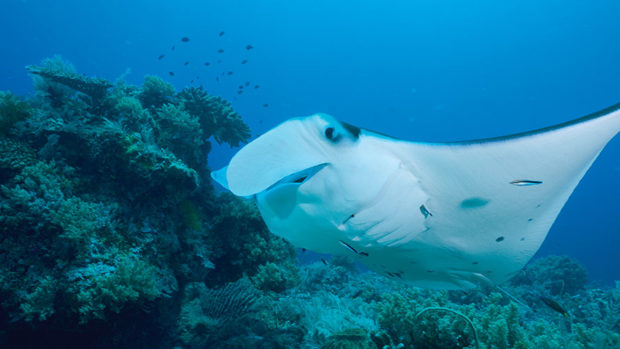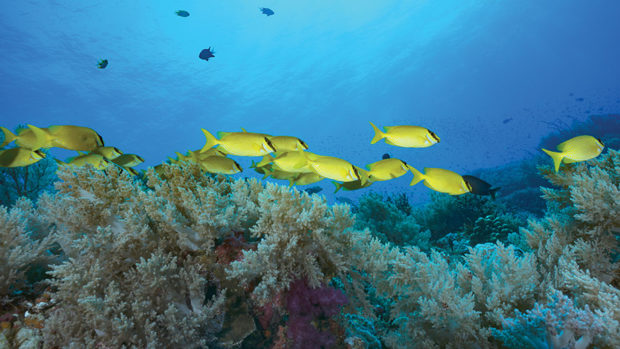The Magic Moment
By Michel Gilbert & Danielle Alary

Underwater photography is made up of many ingredients. Besides technical and behaviour knowledge, dive site information and patience make the perfect shot.
Last year, we had the privilege to dive one of the most pristine areas in the world, the Tubbataha Atolls in the Sulu Sea. We were looking for a specific picture…read on.
Dealing with stress
It is our second visit at Black Rock, a cleaning station located at the Northeastern tip of the South Atoll located within the Tubbataha Reefs Natural Park. Our first outing produced some images but none of the subjects that make this spot so unique.
We are on assignment and we need the shot…
Early in the morning we jump overboard and sink to the bottom, some 30ft (9m) below. There are two cleaning stations at Black Rock. Located some 300ft (90m) apart, they attract a host of “customers” that come from the deep. At this point you can probably guess what we are looking for!
We swim toward station #1 and find it empty. Well, there are some visitors, but not what we are after. Lone sharks patrol, oblivious of the sweetlips that hide among the ten foot (3m)-wide gorgonians.
The current flows gently, helping us remain motionless as we approach station #2. We hope for the best as we look down on the infinite indigo blue of the abyss.
After spending the rest of our Nitrox mix waiting for our subject we surface, empty handed.
Back on board the Azores we switch tanks and sit anxiously as we complete our surface interval. The next dive will be our last at this site. Our blood pressure increases as we come to realize that we may have to settle for less than what
we anticipated.
Great images populate our hard drives after four days spent on the reefs and along the walls of this World Heritage location. Still, we need a more telling picture and the week is almost over. We want a photograph that will summarize, in a fraction of a second, what it means to dive here.

The unforgiving nature
Anyone who takes a camera underwater soon realizes that the best plans do not always work. Despite your technical knowledge, careful research, and even the best dive guide, the marine environment has a life of its own.
As we prepare for the dive, we think about replacements for the elusive picture we have in mind. Yes, the schooling jacks are spectacular; but they do not carry the magic touch of the photograph illustrating our mental storyboard.
When the guide asks us to board the RIB, we remind him of the subject we are looking to find, knowing too well that he has no control over this vast ocean. His knowledge and experience can only achieve so much; the rest is up to mother nature.
Last hope
On this second dive we visit station #2 first with a simple plan: wait for 10 minutes and then move on.
Despite some action, we leave our first stop feeling like a student with no date for the prom. Our heartbeat increases as we near station #1.
We land on sandy patches next to the coral mound where deep sea visitors usually stop. Danielle sits closer to the wall, keeping an eye for potential subjects. Cleaning wrasses wiggle their tails, doing their best impersonation
of the neon signs found on the Las Vegas strip.
After a few minutes, our guide waves his hands in slow motion. This is it!
The dark silhouette glides along the wall, slowly rising in our direction. As it swims above Danielle, a wing gently caresses my buddy’s head.
Be ready
With a camera set for available light photography and strobes adjusted to 1/4 power in order to avoid overexposure of the white underside I concentrate and keep cool.
Finally, the large manta approaches and makes a pass exactly as I had hoped: between me and the coral head.
I document her moves as she comes close and swims away. Out in the distance she turns and comes back, for another pass…and another. Our pas de deux lasts a good 15 minutes.
The storyboard comes true. Long wait and “empty” dives are forgotten as we think lighting and composition.
We had prepared for this instant, made images in our minds, discussed positioning and camera settings. Shutter speed had to be 1/125 and aperture f/16 to maximize corner sharpness. The ambient light level meant using ISO 400, a reasonably noiseless choice.
Planning always pays off: the muscle memory helps to execute the strategy when something happens.
Although luck may strike, it rarely results in great images. Being ready and rehearsed makes the difference.
Never give up, as perseverance often sets apart those who capture the essence of nature. Of course, nailing it at the beginning of a trip keeps your blood pressure down and may, in the end, extend your life expectancy.
However, even when everything happens at the last minute it remains a magic moment!
Leave a Comment







